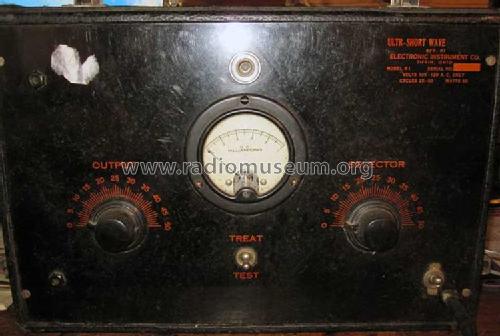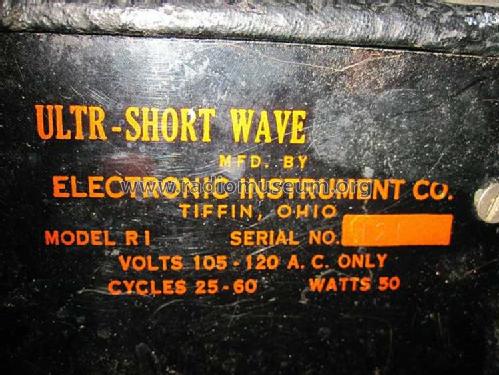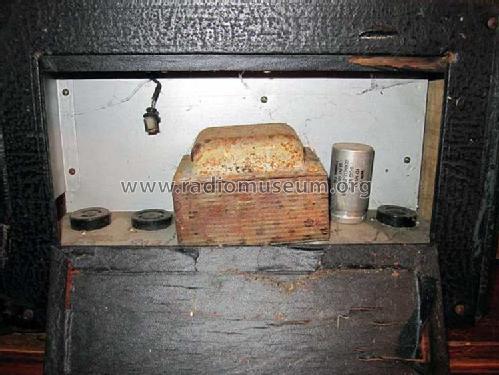R1 - Ultr-Short Wave (not Ultra)
Electronic Instrument Co.; Tiffin, OH.
- Country
- United States of America (USA)
- Manufacturer / Brand
- Electronic Instrument Co.; Tiffin, OH.
- Year
- 1924 ??
- Category
- Miscellaneous (Other, Various) - see notes
- Radiomuseum.org ID
- 209518
- Number of Tubes
- 3
- Wave bands
- Wave Bands given in the notes.
- Power type and voltage
- Alternating Current supply (AC) / 25 - 60 cycles 105 - 120 Volt
- Loudspeaker
- - - No sound reproduction output.
- Material
- Leather / canvas / plastic - over other material
- from Radiomuseum.org
- Model: R1 - Ultr-Short Wave - Electronic Instrument Co.;
- Shape
- Tablemodel, low profile (big size).
- Notes
- This can perhaps be one of the "Black Boxes" this company made. See notice about an other model:
THE RADIOCLAST EXPOSED
Since the death of Albert Abrams in 1924, before he had time to hitch himself up to one of his own machines, various commercial promoters have continued to manufacture devices in imitation of those with which he worked. Somehow our federal agencies have not apparently taken the necessary steps to establish that the promotion of such devices constituted fraud and deception. One organization, however, has publicized the fakery involved. In connection with this effort the manager of the Indianapolis Better Business Bureau had a serious investigation made of one such device. This device, known as the "Radioclast," is manufactured and sold by the Electronic Instrument Company of Tiffin, Ohio. The result of.this investigation, which was publicized in a recent bulletin of the Better Business Bureau, fully justified the conclusion as to the fraudulent character of the Radioclast. The particular device investigated, known as Model 40 ...
From infojustice.com: Beginning in 1924, the Electronic Medical Foundation promoted and distributed 15 different fake health machines of the Abrams vintage. The Depoloray, Depolatron, Oscillioclast, and Electropad were just four of the 15. Dr. Abrams original device is known in our era as the infamous Black Box. It essentially had a small well where the medical physician was to place a personal item of the patient such as a picture of the patient, a piece of clothing worn by the patient, hair and even human tissues. Then a small rubbing plate slid over the well. The physician then rubbed the plate to hear the squeak. In his era not only did the number of the squeaks add up to a type of disease it was also the sound of the squeak. Later Abrams added a dial to increase or decrease frequencies allegedly to simulate the frequency of the patients tissues which produced their own frequency noise! The actual sound was amazing. To this editor the noises produced sounded like those that accompanied early sci-fi movies to give one the willies!
More detailed at devicewatch.org/reg/: This page listas also different sets like: Micro-Dynameter, Oscilloclast, Oscillotron, Regular Push Button Shortwave Oscillocast, Sweep Oscillotron, Sinusoidal Four-in-One Shortwave Oscillotron, Galvanic Five-in-One Shortwave Oscillotron Depolaray, Depolaray Chair, Depolaray Junior, New Depolaray Junior, Depolatron, Depolatron Chair, Electropad, Neurolinometer, Electron-O-Ray Model 51, Quto-Electronic Instrument, Radioclast Model 40, Radioclast Model P, Radioclast Treating Unit, Electron-O-Ray Model 46, Electronic Magnetic Model G, Radioclast Model 40, Auto-Electronic Radioclast Model 20, Series 800 Electronic Analysis Instrument Model F, The Endocardiograph, The Hubbard E-Meter, The Drown Radio Therapeutic Instrument.
- Author
- Model page created by Ernst Erb. See "Data change" for further contributors.
- Other Models
-
Here you find 2 models, 1 with images and 0 with schematics for wireless sets etc. In French: TSF for Télégraphie sans fil.
All listed radios etc. from Electronic Instrument Co.; Tiffin, OH.


